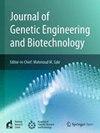利用CAAT箱源多态性(CBDP)和起始密码子靶向多态性(SCoT)标记分析印度黑莓(Syzygium cumini L.)的遗传多样性和群体结构
IF 2.8
Q3 Biochemistry, Genetics and Molecular Biology
Journal of Genetic Engineering and Biotechnology
Pub Date : 2025-02-13
DOI:10.1016/j.jgeb.2025.100468
引用次数: 0
摘要
印度黑莓(Syzygium cumini L.)也被称为jamun,是一种非常重要的未充分利用的水果作物,具有显著的药用和经济价值。然而,其遗传改良一直受到现有馆藏遗传多样性知识有限的制约。因此,利用分子工具全面表征该物种的遗传多样性,对于支持有效的种质资源管理和育种计划的应用至关重要。本研究利用CBDP和SCoT两种基因靶向标记分析了32个jamun基因型,包括30个苗源基因型、1个改良品种CISH J-37和1个野生基因型(Syzygium fruitecosum)。共有29条引物(22条CBDP引物和7条SCoT引物)检测到基因型间的遗传多态性。CBDP标记在291个条带中扩增出94.85%的多态性,而SCoT标记在69个条带中扩增出92.75%的多态性。CBDP和SCoT的平均PIC值分别为0.28和0.31。CBDP组的MI值(3.21)高于SCoT组(2.88)。UPGMA聚类分析鉴定出6个分支,将基因型分为苗源型、改良型和野生型。基于CBDP、SCoT和两者分子谱数据的PCoA分别解释了26.65%、38.39%和23.22%的变异。AMOVA结果显示,85-90%的遗传变异存在于群体内。贝叶斯结构分析将基因型分为两个主要群体,证实了苗源型、改良型和野生型之间的遗传差异。本研究首次将CBDP和SCoT标记整合到印度黑莓的遗传多样性分析中。研究结果强调了这些标记在遗传变异评估中的应用,并将有助于设计该作物的种质保护和育种策略。本文章由计算机程序翻译,如有差异,请以英文原文为准。
Genetic diversity and population structure analysis of Indian blackberry (Syzygium cumini L.) using CAAT box‑derived polymorphism (CBDP) and start codon targeted polymorphism (SCoT) markers
Indian blackberry (Syzygium cumini L.) also known as jamun is a very important underutilized fruit crop with notable medicinal and economic value. However, its genetic improvement has been constrained by limited knowledge of the genetic diversity within existing collections. Therefore, a comprehensive characterization of genetic diversity in this species, using molecular tools, is essential to support effective germplasm management and application in breeding programs. In this investigation, a total of 32 jamun genotypes consisting of 30 seedling-origin genotypes, one improved cultivar CISH J-37 and one wild genotype (Syzygium fruitecosum) were analysed using the two gene-targeted markers, CBDP and SCoT. In total, 29 primers (22 CBDP and 7 SCoT primers) detected genetic polymorphism across the genotypes. The CBDP markers amplified a higher polymorphism percentage, 94.85% across 291 bands, than the SCoT markers, 92.75% across 69 bands. The mean PIC values for CBDP and SCoT were 0.28 and 0.31, respectively. MI values were higher for CBDP (3.21) than for SCoT (2.88). Cluster analysis using UPGMA identified six clades, which grouped genotypes into seedling-origin, improved and wild categories. The PCoA based on molecular profiling data of CBDP, SCoT and both together explained 26.65%, 38.39% and 23.22% of the variation respectively. AMOVA results revealed that 85–90% of genetic variation existed within populations. Bayesian STRUCTURE analysis grouped genotypes into two major populations confirming genetic divergence between seedling-origin, improved and wild genotypes. This study is the first to integrate CBDP and SCoT markers for genetic diversity analysis of the Indian blackberry. The results highlight the utility of these markers in genetic variation assessment and would help design germplasm conservation and breeding strategies in this crop.
求助全文
通过发布文献求助,成功后即可免费获取论文全文。
去求助
来源期刊

Journal of Genetic Engineering and Biotechnology
Biochemistry, Genetics and Molecular Biology-Biotechnology
CiteScore
5.70
自引率
5.70%
发文量
159
审稿时长
16 weeks
期刊介绍:
Journal of genetic engineering and biotechnology is devoted to rapid publication of full-length research papers that leads to significant contribution in advancing knowledge in genetic engineering and biotechnology and provide novel perspectives in this research area. JGEB includes all major themes related to genetic engineering and recombinant DNA. The area of interest of JGEB includes but not restricted to: •Plant genetics •Animal genetics •Bacterial enzymes •Agricultural Biotechnology, •Biochemistry, •Biophysics, •Bioinformatics, •Environmental Biotechnology, •Industrial Biotechnology, •Microbial biotechnology, •Medical Biotechnology, •Bioenergy, Biosafety, •Biosecurity, •Bioethics, •GMOS, •Genomic, •Proteomic JGEB accepts
 求助内容:
求助内容: 应助结果提醒方式:
应助结果提醒方式:


